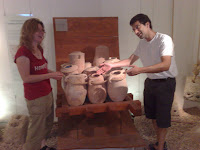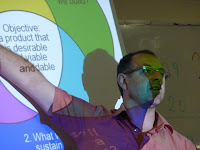 On Tuesday I was at the German human computer interaction conference called Mensch und Computer. The keynote by Alex Kirlik was on Ethical Design (slides from his talk) and he showed how ethics extends beyond action to technology leading to the central question: Why should we build certain systems? His examples and the following discussion made me wonder whether „Ethics become the next Material for innovation“. Taking his example of 9/11 where old technology (air planes) and a different view on ethics was used to strike this is in contrast to previous/typical warfare where new technologies (e.g. Gun powder, Nuclear bomb) have changed the way wars are conducted.
On Tuesday I was at the German human computer interaction conference called Mensch und Computer. The keynote by Alex Kirlik was on Ethical Design (slides from his talk) and he showed how ethics extends beyond action to technology leading to the central question: Why should we build certain systems? His examples and the following discussion made me wonder whether „Ethics become the next Material for innovation“. Taking his example of 9/11 where old technology (air planes) and a different view on ethics was used to strike this is in contrast to previous/typical warfare where new technologies (e.g. Gun powder, Nuclear bomb) have changed the way wars are conducted.
Considering ethics as material for innovation is obviously risky but looking at successful businesses of the last decade such a trend can be argued for (e.g. google collecting information about the user to provide new services, youtube allowing users to share content with limited insurance that it is not copyrighted). Would be interesting to have a workshop on this topic sometime in the future…
 Grace who left our group after finishing her Master’s degree (to work in the real world outside of university 😉 presented her paper on how to aid communication in the car between driver and passenger [1].
Grace who left our group after finishing her Master’s degree (to work in the real world outside of university 😉 presented her paper on how to aid communication in the car between driver and passenger [1].
In the afternoon the working group on tangible interaction in mixed realities (in German Be-greifbare Interaktion in Gemischten Wirklichkeiten) had a workshop and a meeting. We will host the next workshop of the working group in Essen early next year (probably late February or early March).
PS: the next Mensch & Computer Conference ist at the University of Duisburg-Essen 🙂
[1] Grace Tai, Dagmar Kern, Albrecht Schmidt. Bridging the Communication Gap: A Driver-Passenger Video Link. Mensch und Computer 2009. Berlin.










